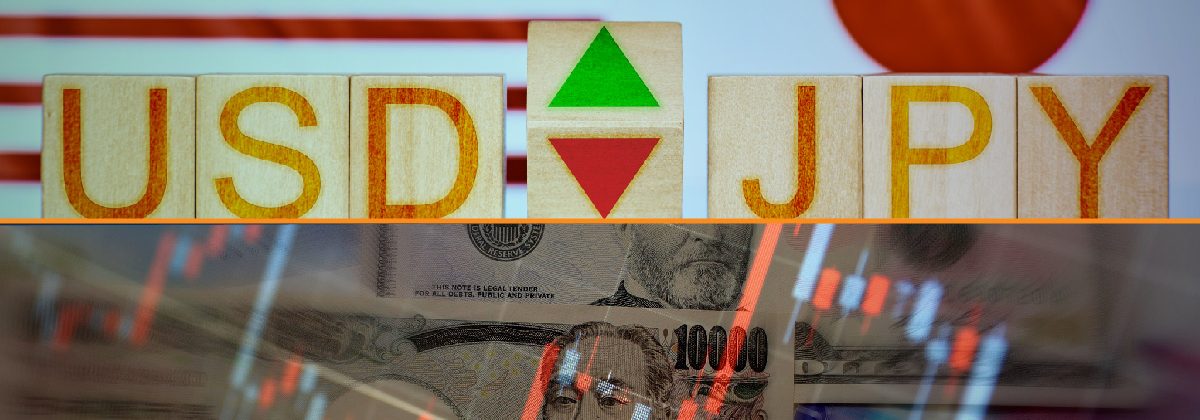How to Capture USD/JPY Trading Opportunities

The US dollar/Japanese yen (USD/JPY) is among the most actively traded forex pairs. Its popularity means that liquidity and trading volumes tend to be high, leading to tighter spreads and lower chances of slippage. The pair has risen 40.43% in the five years to July 2024. Macroeconomic factors play a key role in determining the exchange rates of this currency pair, making it crucial for traders to keep a close eye on economic data releases.
Here’s a closer look at the factors that move the USD/JPY for informed trading.
Did You Know?
Like the US dollar, the Japanese yen is considered a safe-haven currency, meaning that traders tend to flock to these currencies during uncertain times. For example, the USD/JPY saw a significant drop during the 2008 financial crisis as investors flocked to the safe-haven yen. Similarly, investors sought refuge in the JPY during the 2020 pandemic, leading to the forex pair declining.
Factors that Move the USD/JPY
Factors associated with the economic and political conditions of not just the US and Japan, but also other countries tend to play a role in moving the USD/JPY pair. The most influential factors include:
Central Bank Policies
The monetary policies of the Federal Reserve (Fed) and Bank of Japan (BoJ) play a significant role in determining the strength of their domestic currencies. Among these policies, interest rate decisions are a key factor. When the Fed raises interest rates, the USD strengthens. This is because higher interest rates make the currency more attractive to investors. Similarly, the JPY strengthens when the BoJ raises interest rates.
Economic Data Releases
Economic data, such as the nation’s GDP, unemployment rate and inflation rate, reflect its economic health. Therefore, positive or better-than-expected data strengthens the domestic currency, while poorer-than-expected numbers can weaken the currency. Every nation, including the US and Japan, releases various economic indicators at specific times each month, quarter or annually. You can stay updated on these dates through an economic calendar, which also includes market expectations regarding each dataset and the previous figure. This can help you prepare in advance for the data release.
For example, inflation declined in the US for the third straight month in June 2024, coming in at 3%, below the consensus estimate of 3.1% Yet, the greenback saw selling pressure after the data release, falling 0.53% against the yen. This was driven by increased expectations that the Fed would start cutting interest rates from September. This only goes to show how forex prices can also move as a result of the interplay between different factors.
Did You Know?
The USD/JPY pair is positively correlated with the global stock markets, especially the US stock market. This means that when the US stock market rises, the forex pair also tends to rise, and vice versa.
Geopolitical Conditions
Political developments and announcements tend to impact the USD/JPY. This is why forex traders are keeping a close eye on the US presidential election, scheduled for November 2024. Also, if a new trade deal is signed by Japan that is expected to boost the economy, it could strengthen the yen against the US dollar. So, government policies also impact the forex pair.
In addition, geopolitical tensions, such as trade wars, political conflicts or military confrontations, lead investors to flock to safe-haven investments. This was observed in the aftermath of the Russian invasion of Ukraine and the following sanctions on Russia, which led to supply chain disruptions for many parts of the world. Similarly, the prolonged crisis in the Middle East created uncertainty in the markets, which made safe-haven investments more attractive.
Market Sentiment
Market sentiment reflects the overall mood of investors towards a currency. It is impacted by various factors, including economic data, geopolitical events, and global risk appetite. Optimism regarding the US or Japanese economy or the global economic situation tends to increase risk appetite among traders, which makes them seek out higher risk/higher return assets. Conversely, pessimistic market sentiment tends to lead to risk-averse trading, where traders prefer safe-haven assets. So, strong US GDP growth can lead to bullish sentiment towards the greenback, leading the USD/JPY rate to rise.
Did You Know?
The USD/JPY is positively correlated with US treasury yields, the CAD/JPY and SGD/JPY, while being negatively correlated with gold prices, the EUR/USD and the AUD/USD. Trading uncorrelated or negatively correlated assets can be an effective way to diversify your portfolio.
Trade and Capital Flows
Capital flow and trade between the US and Japan also tend to influence the US dollar/Japanese yen forex pair. If America imports more goods and services from Japan than it exports, the demand for the JPY tends to rise, which can lead to a depreciation of the USD/JPY. On the other hand, if capital flows into the US from Japan, the demand for the USD is likely to rise, leading to the currency pair appreciating.
Trading the USD/JPY
Contracts for difference (CFDs) are a popular way to trade forex, including the dollar/yen pair. This is because it allows you to speculate on the currency pair’s move without needing to own either currency. You also get to trade using leverage, which means you can increase your exposure to the forex market beyond the funds in your trading account. However, remember that increasing market exposure magnifies both profit and loss potential. Therefore, appropriate risk management measures are indispensable for CFD-based FX trading strategies.
To Sum Up
- The USD/JPY is one of the most actively traded currency pairs, leading to high liquidity and trading volumes.
- Economic data from the US and Japan impact the forex pair, such as GDP and employment numbers, inflation rate, etc.
- Geopolitical factors also lead to forex moves in this currency pair, such as political instability, elections and geopolitical tensions.
- Market sentiment towards a currency affects its strength.
- Trade and capital flows between the US and Japan also impact the USD/JPY.
- CFDs are a popular FX trading strategy for this currency pair.
Disclaimer
All data, information and materials are published and provided “as is” solely for informational purposes only, and is not intended nor should be considered, in any way, as investment advice, recommendations, and/or suggestions for performing any actions with financial instruments. The information and opinions presented do not take into account any particular individual’s investment objectives, financial situation or needs, and hence does not constitute as an advice or a recommendation with respect to any investment product. All investors should seek advice from certified financial advisors based on their unique situation before making any investment decisions in accordance to their personal risk appetite. Blackwell Global endeavours to ensure that the information provided is complete and correct, but make no representation as to the actuality, accuracy or completeness of the information. Information, data and opinions may change without notice and Blackwell Global is not obliged to update on the changes. The opinions and views expressed are solely those of the authors and analysts and do not necessarily represent that of Blackwell Global or its management, shareholders, and affiliates. Any projections or views of the market provided may not prove to be accurate. Past performance is not necessarily an indicative of future performance. Blackwell Global assumes no liability for any loss arising directly or indirectly from use of or reliance on such information here in contained. Reproduction of this information, in whole or in part, is not permitted.




